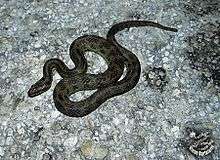Nerodia clarkii
Nerodia clarkii, commonly known as the salt marsh snake, is a species of semiaquatic, nonvenomous, colubrid snake found in the southeastern United States, in the brackish salt marshes along the Gulf of Mexico from Florida to Texas, with a population in northern Cuba.
| Nerodia clarkii | |
|---|---|
 | |
| N. clarkii compressicauda, red color phase | |
 | |
| N. clarkii compressicauda, normal color phase | |
| Scientific classification | |
| Kingdom: | Animalia |
| Phylum: | Chordata |
| Class: | Reptilia |
| Order: | Squamata |
| Suborder: | Serpentes |
| Family: | Colubridae |
| Genus: | Nerodia |
| Species: | N. clarkii |
| Binomial name | |
| Nerodia clarkii | |
| Synonyms[2] | |
| |
.jpg)
Etymology
The specific name, clarkii, is in honor of American surveyor and naturalist John Henry Clark (1830-1885).[3]
Description
Salt marsh snakes grow to a total length of 15 inches (38 cm) to 30 inches (76 cm), and are highly variable in pattern and coloration. Populations of the Gulf salt marsh snake (N. c. clarkii) from the vicinity of Corpus Christi, Texas, to the Gulf Hammock region of Florida are gray, tan or yellow with four brown to black longitudinal stripes.
Populations in Florida from Tampa Bay south to Miami and northward along the Atlantic coast to the vicinity of Cape Canaveral are referred to as the mangrove salt marsh snake (N. c. compressicauda). This subspecies exhibits many colors and patterns and can be gray, green, or tan with darker banding or may even be solid reddish orange or straw yellow.
A third subspecies, the Atlantic salt marsh snake (N. c. taeniata), is restricted to a small stretch of coastline in Volusia and Indian River Counties, Florida. This race is smaller than the other two and has a color pattern of four dark stripes on the neck which are replaced by a series of dark blotches or bands on the posterior portion of the snake's body. It is currently listed as a Threatened Species by the US Fish and Wildlife Service.
Taxonomy
Some sources consider the three races of N. clarkii to be subspecies of the southern water snake, Nerodia fasciata.[4][5] Others consider not only the three races of N. clarkii, but also the species N. fasciata itself, all to be subspecies of N. sipedon.[6][7]
Subspecies
There are three recognized subspecies of N. clarkii, including the nominotypical subspecies:
- Nerodia clarkii clarkii (Baird & Girard, 1853) – Gulf salt marsh snake
- Nerodia clarkii compressicauda (Kennicott, 1860) – mangrove salt marsh snake
- Nerodia clarkii taeniata (Cope, 1895) – Atlantic salt marsh snake
References
- Hammerson GA (2007). "Nerodia clarkii ". The IUCN Red List of Threatened Species. IUCN. 2007: e.T63852A12722122. doi:10.2305/IUCN.UK.2007.RLTS.T63852A12722122.en. Retrieved 23 December 2017.
- "Nerodia clarkii ". The Reptile Database. www.reptile-database.org.
- Beolens, Bo; Watkins, Michael; Grayson, Michael (2011). The Eponym Dictionary of Reptiles. Baltimore: Johns Hopkins University Press. xiii + 296 pp. ISBN 978-1-4214-0135-5. (Nerodia fasciata clarkii, p. 55).
- Conant R (1975). A Field Guide to Reptiles and Amphibians of Eastern and Central North America, Second Edition. Boston: Houghton Mifflin. xviii + 429 pp. + Plates 1-48. ISBN 0-395-19979-4 (hardcover), ISBN 0-395-19977-8 (paperback). (Natrix fasciata clarki, pp. 147-148; N. f. taeniata, p. 148; N. f. compressicauda, pp. 148-149; Plate 21; Map 101).
- Smith HM, Brodie ED Jr (1982). Reptiles of North America: A Guide to Field Identification. Golden Press. New York. 240 pp. ISBN 0-307-13666-3 (limp). (Nerodia fasciata clarki, N. f. compressicauda, N. f. taeniata, pp. 156-157).
- Schmidt KP, Davis DD (1941). Field Book of Snakes of the United States and Canada. New York: G.P. Putnam's Sons. xiii + 365 pp. (Natrix sipedon clarkii, N. s. compressicauda, pp. 222-224 + Figure 72 [map] on p. 221).
- Wright AH, Wright AA (1957). Handbook of Snakes of the United States and Canada. Ithaca and London: Comstock. 1,105 pp. (in 2 volumes) (Natrix sipedon clarki, N. s. compressicauda, pp. 515-522, Figures 151-154; N. f. taeniata, pp. 541-544, Figure 161; Map 40 on p. 491).
Further reading
- Baird SF, Girard CF (1853). Catalogue of North American Reptiles in the Museum of the Smithsonian Institution. Part I.—Serpents. Washington, District of Columbia: Smithsonian Institution. xvi + 172 pp. (Regina clarkii, new species, p. 48).
- Boulenger GA (1893). Catalogue of the Snakes in the British Museum (Natural History). Volume I., Containing the Families ... Colubridæ Aglyphæ, part. London: Trustees of the British Museum (Natural History). (Taylor and Francis, printers). xiii + 448 pp. + Plates I-XXVIII. (Tropidonotus clarkii, p. 238).
- Conant R, Bridges W (1939). What Snake Is That?: A Field Guide to the Snakes of the United States East of the Rocky Mountains. (With 108 drawings by Edmond Malnate). New York and London: D. Appleton-Century Company. Frontispiece map + viii + 163 pp. + Plates A-c, 1-32. (Natrix sipedon clarkii, pp. 105–106 + Plate 20, Figure 57).
- Cope ED (1895). "On some new North American Snakes". American Naturalist 29: 676-680. (Natrix compressicauda tæniata, new subspecies, pp. 676–677).
- Kennicott R (1860). "Descriptions of New Species of North American Serpents in the Museum of the Smithsonian Institution, Washington". Proc. Acad. Nat. Sci. Philadelphia 12: 328-338. (Nerodia compressicauda, new species, pp. 335–336).
- Powell R, Conant R, Collins JT (2016). Peterson Field Guide to Reptiles and Amphibians of Eastern and Central North America, Fourth Edition. Boston and New York: Houghton Mifflin Harcourt. xiv + 494 pp., 47 Plates, 207 Figures. ISBN 978-0-544-12997-9. (Nerodia clarkii, pp. 414–415 + Plate 40).
More external links
| Wikispecies has information related to Nerodia clarkii |
| Wikimedia Commons has media related to Nerodia clarkii. |
- Species Nerodia clarkii at The Reptile Database
